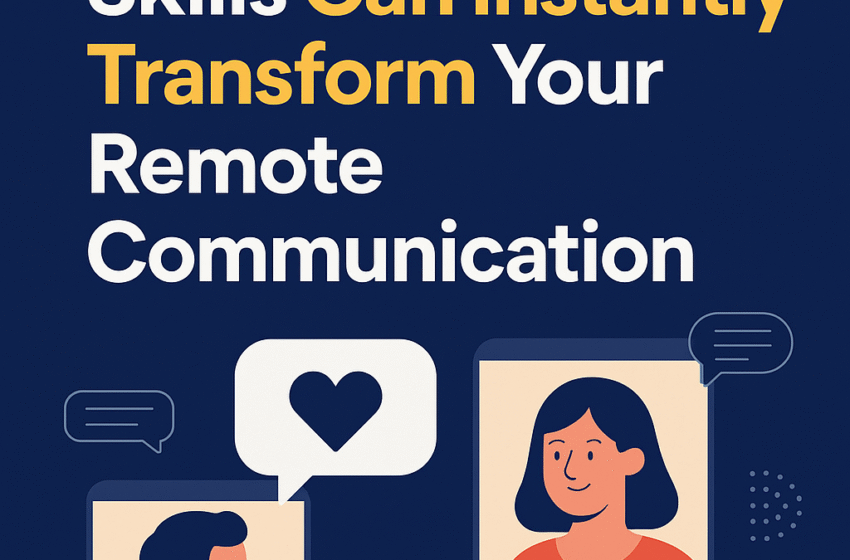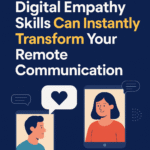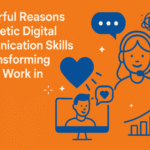

Introduction
Digital empathy skills are rapidly becoming a cornerstone of successful remote work. As digital collaboration becomes the norm, miscommunications and emotional disconnects are more frequent. You’ve probably experienced a situation where an email felt a little too blunt or a message lacked clarity. They might think empathy is optional, but for me—and for you—it’s an essential tool. In this article, I’ll share five powerful strategies that are emotionally intelligent, practical, and easy to apply in your digital interactions.
Why Digital Empathy Skills Are Trending
While communication and teamwork are often the highlights of digital soft skills, digital empathy skills remain underrated yet vital. According to Pegon Academy’s post on empathetic communication in remote work, empathy in virtual interactions is now viewed as a core driver of trust, productivity, and collaboration (source).
Furthermore, Search Engine Land points out that storytelling, clarity, and empathy are now considered must-have soft skills for digital professionals, particularly in SEO and content development (Search Engine Land). These skills are evergreen and applicable across industries—from tech and healthcare to education and e-commerce.
What Are Digital Empathy Skills?
Digital empathy skills refer to the ability to recognise, understand, and appropriately respond to emotions expressed through digital communication channels such as emails, instant messages, or video calls. These include:
- Reading tone and emotional cues in written communication
- Responding with thoughtful, emotionally aware language
- Practising active listening—even in asynchronous conversations
- Offering validation, encouragement, or compassion through text or speech
This kind of empathy reduces misunderstandings, boosts morale, and fosters healthier digital workspaces.
Related Reads on Pegon Academy
5 Proven Strategies to Strengthen Your Digital Empathy Skills
1. Pause, Reread, and Reflect Before Hitting Send
It’s easy to shoot off a quick message, but I’ve learned that taking a moment to reread helps catch unintended tones. Whether you’re replying to a complaint or giving feedback, taking the time to reflect before responding ensures your tone is respectful and empathetic.
2. Use Active Listening Cues in Text
In verbal communication, active listening is obvious. But in digital communication, you need to show attentiveness with words. Try phrases like, “If I’m understanding correctly…” or “That sounds frustrating want to talk more about it?” These cues reassure the recipient that you’re genuinely engaged.
3. Choose the Right Communication Channel
Sometimes a quick message won’t do justice to the conversation. If emotions run high, consider switching to a voice call or video chat. Tone of voice and facial expressions add crucial context and can prevent misinterpretation.
4. Acknowledge Emotions Explicitly
When someone expresses stress, confusion, or excitement, respond empathetically. A simple “That sounds like a lot to handle—how can I help?” goes a long way. Emotional validation builds trust and rapport, especially in digital spaces where misunderstandings are common.
5. Lead by Example
Empathetic leadership sets the tone for your entire team. Check in when someone’s behaviour shifts or their tone changes. Asking, “Is everything okay?” demonstrates concern and can open the door to honest communication. Modelling empathy encourages your team to do the same.
Real-World Example
I recall a time when a teammate misunderstood my message in Slack and felt slighted. Rather than defend myself immediately, I messaged: “Hey, I sense some tension. Want to hop on a quick call to clear things up?” That small gesture turned what could’ve become a conflict into a productive and supportive conversation.
Benefits of Developing Digital Empathy Skills
| Benefit | What it Means for You |
|---|---|
| Fewer Misunderstandings | Clearer conversations and fewer conflicts |
| Stronger Remote Teamwork | Builds connection and trust |
| Improved Leadership Presence | Seen as thoughtful and emotionally aware |
| Healthier Work Environment | Less digital friction, more support |
Expert Insights
Search Engine Land notes that emotional intelligence and empathy are increasingly valued in a data-driven, AI-enhanced digital workplace. These skills not only improve internal communication but also enhance user-focused content marketing efforts (Search Engine Land).
Additionally, Pegon Academy provides a growing collection of actionable guides on how empathy enhances digital workspaces and project success.
Quick Recap
- Digital empathy skills are essential for effective remote communication
- Practice emotional awareness through simple habits like rereading and tone-checking
- Choose the right communication channels for emotional conversations
- Acknowledge emotions directly to build trust
- Lead with empathy to create a positive team culture
FAQs
Q: Do digital empathy skills really affect productivity?
Absolutely. Studies show that emotionally intelligent teams solve problems faster and communicate more effectively.
Q: Can empathy be taught or improved over time?
Yes, with conscious practice, you can significantly improve your empathy skills even digitally.
Conclusion and Call to Action
Digital empathy skills may not come naturally in online settings, but they can be learned, practised, and mastered. By adopting the five strategies shared in this article, you’ll not only improve your communication you’ll positively influence the tone and culture of your virtual workplace.
Start today. Pick one strategy, whether it’s rereading your messages or actively acknowledging someone’s feelings. With time, you’ll notice fewer misunderstandings and stronger professional relationships.
Want more digital soft skills tips? Explore the full catalogue of communication and leadership guides on Pegon Academy.
Let’s make digital spaces more human—one empathetic message at a time.




